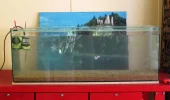Hi all,
I've taken the bait hook, line and sinker, more than you could ever imagine and I've decided my ad hoc aquarium keeping needs to be shut down and restarted from scratch..
I've a new tank and it's all clean and scrubbed and I'm ready to go....
Will plan on just running seawater for the next month or three to get a good understanding of the N cycle...
Which brings me to my first of many, many question....
Previously,I've always used crushed coral and am now aware of its limitations; detritus collection, nitrate harbouring etc...
Obviously sand is very beneficial in the biological filtration and I'm assuming the finer the sand the better?
Will eventually run a sump/refugium with deep sand later on, but at the moment I'm just going to run my main tank isolated....1 - 1.5 inches of fine sand the best way to go?
Also I'll add a nice piece of live rock to kick start the cycle and start monitoring the Ammonia spike..
Thanks again,
Standby for a barrage of questions......the chemical/biological process of this is what is interesting me the most....not too fussed about species...
I've taken the bait hook, line and sinker, more than you could ever imagine and I've decided my ad hoc aquarium keeping needs to be shut down and restarted from scratch..
I've a new tank and it's all clean and scrubbed and I'm ready to go....
Will plan on just running seawater for the next month or three to get a good understanding of the N cycle...
Which brings me to my first of many, many question....
Previously,I've always used crushed coral and am now aware of its limitations; detritus collection, nitrate harbouring etc...
Obviously sand is very beneficial in the biological filtration and I'm assuming the finer the sand the better?
Will eventually run a sump/refugium with deep sand later on, but at the moment I'm just going to run my main tank isolated....1 - 1.5 inches of fine sand the best way to go?
Also I'll add a nice piece of live rock to kick start the cycle and start monitoring the Ammonia spike..
Thanks again,
Standby for a barrage of questions......the chemical/biological process of this is what is interesting me the most....not too fussed about species...
Last edited:


